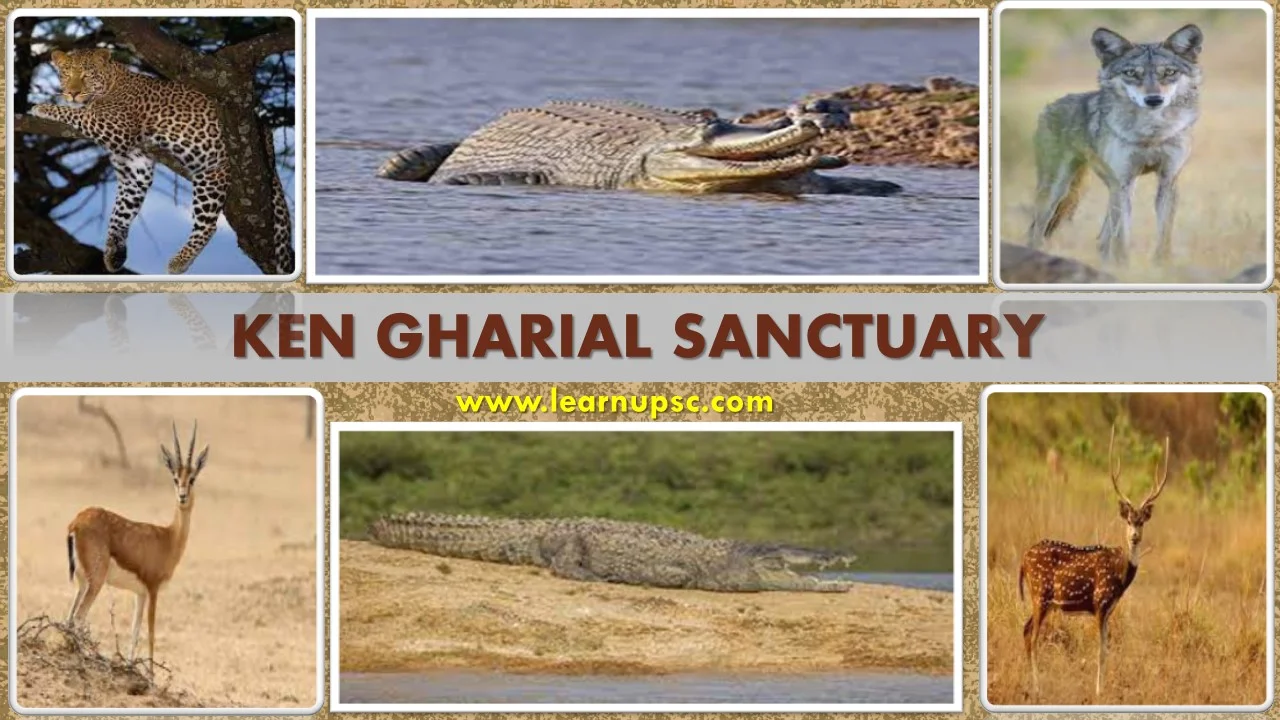Ken Gharial Sanctuary UPSC
The Ken Gharial Sanctuary is a wildlife sanctuary located in the state of Madhya Pradesh, India. It was established with the aim of conserving gharials and mugger crocodile populations.
The sanctuary is known for being the habitat of gharials. Additionally, as part of the Panna Tiger Reserve, it is home to various other wildlife species.
|
Table of Contents
|
Ken Gharial Sanctuary Location
The Ken Gharial Sanctuary is located in the Panna and Chhatarpur Districts of Madhya Pradesh, India. It is situated at the confluence of the Ken River and Khudar River. The sanctuary is positioned northeast of the Khajuraho temples and to the north of the Panna National Park.
Nearest Airport:
The nearest airport to the Ken Gharial Sanctuary is the Khajuraho Airport. It is located at a distance of approximately 35 kilometers from the sanctuary.
Railway Station:
The closest railway station to the Ken Gharial Sanctuary is the Khajuraho Railway Station. It is located at a distance of about 28 kilometers from the sanctuary.
Ken Gharial Sanctuary History
The Ken Gharial Sanctuary was established in 1981 with the primary purpose of conserving and protecting the populations of gharials and mugger crocodiles.
Gharials are a critically endangered species of crocodiles native to the Indian subcontinent. They have long, slender snouts and are known for their unique appearance. Due to habitat loss, pollution, and illegal poaching, their numbers have drastically declined, leading to the establishment of various conservation efforts and sanctuaries like the Ken Gharial Sanctuary.
By setting up the sanctuary, authorities aimed to create a safe and suitable environment for these endangered crocodiles to breed, nest, and thrive. Additionally, the sanctuary serves to protect the habitats of other wildlife species that coexist in the region.
Over the years, the Ken Gharial Sanctuary has played a vital role in raising awareness about the conservation of gharials and promoting eco-tourism, offering visitors a chance to observe these fascinating creatures in their natural habitat while also appreciating the diverse wildlife of the area.
Ken Gharial Sanctuary Area
The Ken Gharial Sanctuary is spread over an area of approximately 45.201 square kilometers. The vast expanse of the sanctuary provides a diverse and suitable habitat for the conservation of gharials and mugger crocodiles, along with other wildlife species that inhabit the region.
The sanctuary's considerable area allows for the preservation of critical river habitats and nesting sites essential for the breeding and survival of these endangered reptiles. The diverse landscapes area within the sanctuary, which include rocky regions and dry deciduous forests, contribute to the overall biodiversity of the area, making it an important conservation site for various flora and fauna.
Ken Gharial Sanctuary River
The Ken Gharial Sanctuary is situated at the confluence of two rivers: the Ken River and the Khudar River. These two rivers merge within the sanctuary's boundaries, creating a unique and diverse habitat for various wildlife, including gharials (gharial crocodiles) and mugger crocodiles.
The Ken River is a major river in central India, flowing through the states of Madhya Pradesh and Uttar Pradesh. It is a lifeline for the region, supporting a rich ecosystem and providing water for the diverse flora and fauna that inhabit its banks. The presence of the Ken River within the sanctuary's boundaries contributes significantly to the availability of suitable river habitats, which are essential for the breeding and survival of the endangered gharials.
The Khudar River is likely a smaller river or tributary that joins the Ken River at the sanctuary. Although it might not be as prominent as the Ken River, it still contributes to the overall hydrology and ecology of the sanctuary.
The confluence of these two rivers provides a dynamic and fertile environment for the flora and fauna of the Ken Gharial Sanctuary. The sanctuary's unique location at the intersection of these water bodies makes it an ideal habitat for various wildlife species, attracting both animals and visitors alike to witness the beauty and diversity of the region.
Ken Gharial Sanctuary Flora
The Ken Gharial Sanctuary boasts a varied flora, which is well-adapted to the region's dry and rocky terrain. While the sanctuary may not have dense vegetation due to the arid conditions, it still supports a range of plant species that play a vital role in the ecosystem. Some of the prominent flora found in the Ken Gharial Sanctuary includes:
- Teak (Tectona grandis)
- Seja (Salmalia malabarica)
- Salai (Boswellia serrata)
- Gunja (Abrus precatorius)
- Flame of Forest (Palash or Butea monosperma)
- Khair (Acacia catechu)
Ken Gharial Sanctuary Fauna (Ken Gharial Sanctuary Animals)
The Ken Gharial Sanctuary is not only known for its efforts in conserving gharials and mugger crocodiles but also for its rich and diverse fauna. The sanctuary, being part of the Panna Tiger Reserve, offers a suitable habitat for various wildlife species.
Some of the prominent fauna found in the Ken Gharial Sanctuary includes:
Mammals:
- Indian Wolf
- Nilgai
- Dhole
- Chinkara
- Spotted Deer
- Jackal
- Indian Fox
- Wild Boar
- Hyena
- Sloth Bear
- Leopard
- Common Langur
Birds:
- Peacock
- Waterfowl
- Water Birds
Reptiles:
- Gharial
- Mugger Crocodile
- Monitor Lizards
Ken Gharial Sanctuary UPSC Questions
Q. Where is Ken Gharial Sanctuary located?
A. The Ken Gharial Sanctuary is located in the Panna and Chhatarpur Districts of Madhya Pradesh, India. It is situated at the confluence of the Ken River and Khudar River.


No comments:
Post a Comment